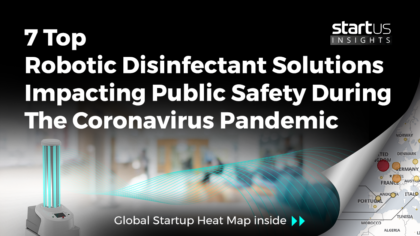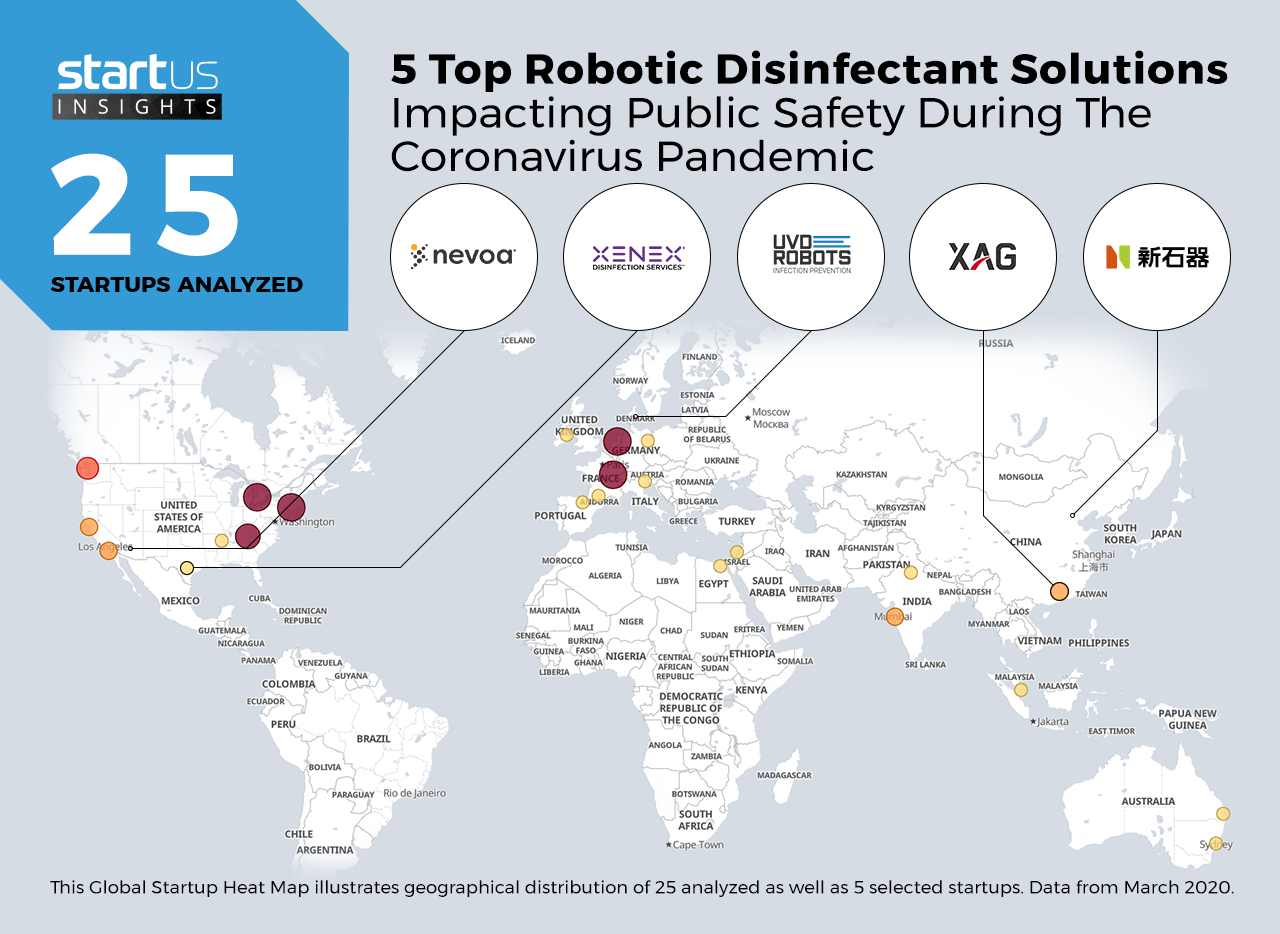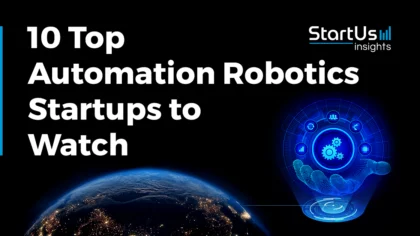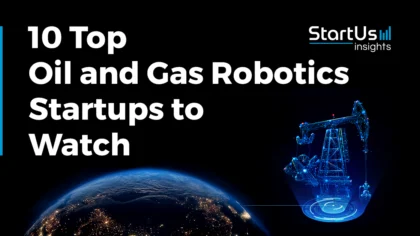Accelerate Productivity in 2025
Reignite Growth Despite the Global Slowdown
To prevent the spread of the coronavirus inside hospitals and other public places, it is essential to keep surfaces disinfected. But the manual cleaning process is dangerous, considering the possibility of getting infected. That’s why it is a perfect task for autonomous disinfection robots. Our Innovation Analysts recently looked into emerging technologies and up-and-coming startups working on public safety solutions that ensure safety for medical and health workers and for the larger public. This time, we take a look at top robotic disinfectant solutions.
Heat Map: 5 Top Robotic Disinfectant Solutions
We use a data-driven startup scouting approach to identify the most relevant solutions globally. The Global Startup Heat Map below highlights 5 interesting examples out of 25 relevant solutions. We analyzed technology-driven solutions that ensure public safety and health for millions of people around the world. UVD Robots, Xenex Disinfection Services, Nevoa, Neolix, and XAG develop 5 top solutions to watch out for!
Nevoa – Room Disinfecting System
Besides non-chemical disinfection methods like ultraviolet (UV) light, there are other ways to rapidly kill bacteria – by using chemical disinfectants. These disinfectants kill bacteria by damaging their proteins or by interfering with their metabolism. The choice and intensity of a disinfectant depend on its requirements – some have a wide-spectrum, that is, they kill many different types of microorganisms while others kill a narrower range of disease-causing organisms.
Scottish company Nevoa develops robotic disinfectant solutions that demonstrate high effectiveness against SARS-CoV-2, for example. Their no-touch hospital disinfection robot, Nimbus, utilizes a hypochlorous acid solution for disinfecting rooms and surfaces. Nimbus atomizes their microburst cleaning solution, an EPA-registered hospital-grade disinfectant, and completely removes its disinfectant cloud after completing the cleaning process.
Xenex Disinfection Services – Xenon Light-Based Disinfection System
Most UV light disinfection devices use mercury gas bulbs as a light source with an effective wavelength of 254 nm. The ultraviolet radiation emitted by low-pressure mercury bulbs is delivered in a continuous stream that gradually accumulates to microorganisms lethal doses. Pulsed xenon ultraviolet (PX-UV) is an alternative to traditional UV methods offering high-intensity pulse germicidal UV. It is emitted in short, high-intensity pulses, possibly requiring a shorter duration of exposure, to achieve lethal doses. PX-UV light potentially possesses greater efficacy than other forms of UV, such as mercury UV, because of its broad-spectrum and greater intensity.
The US-based company Xenex Disinfection Services creates LightStrike robots that use pulsed xenon light to disinfect different hospital areas. Xenex’s patented pulsed xenon Full Spectrum UV room disinfection system eliminates harmful bacteria, viruses, and spores. The system is capable of killing C. diff, MRSA, VRE, and other multidrug-resistant organisms in a shorter time than other UV light devices.
UVD Robots – UV Disinfection Robot
Ultraviolet light is clinically proven as an effective disinfectant. It kills diseases, viruses, bacteria, and other types of microorganisms in the environment by breaking down their DNA-structure. Ultraviolet lamps suit small spaces, such as hospital rooms, as well as larger areas like airports and malls.
Danish startup UVD Robots produces UV-C disinfection robots for patient rooms, corridors, and other units in hospitals. The machines emit ultraviolet light that decontaminates surfaces by tearing apart strands of virus DNA. The robot scans the environment using LiDAR technology and creates a digital map. It then relies on Simultaneous Localization and Mapping (SLAM) to navigate and operate completely autonomously. The robot operates only when people are not around, using its sensors to detect motion and shutting the UV lights off if an individual is around.
XAG – Drone-Based Disinfection
Along with self-driving vehicles, drones also find innovative use cases in today’s lockdown situation. Agricultural drones are already in operation as autonomous precision spraying machines, as they are suitable for releasing disinfectants in public places. These drones are faster and therefore able to cover far more distances compared to traditional methods while keeping human operators out of potential exposure to both the virus and the disinfectant.
Chinese company XAG manufactures industrial Unmanned Aerial Systems (UAS) and established a special fund for a drone disinfection operation to fight COVID-19. The company uses its own agricultural drones to disperse disinfectants to improve public hygiene and reduce the risk of transmitting the virus through surface contact, also known as fomites.
Neolix – Autonomous Vehicles For Disinfecting
Autonomous vehicles have proven themselves extremely useful during this coronavirus outbreak, aside from their core offerings and applications. Their vehicles are capable of delivering medical supplies and food to residences, meals for overworked health workers on the front lines, and also distribute disinfectant in cities’ streets.
Neolix is a self-driving delivery vehicle startup from China that upgraded its vans in response to the coronavirus situation. Robotic vehicles drive around the city and atomize the disinfectants to help curb the spread of the virus. Neolix’s vans use a combination of sensors and high-definition maps in order to detect and avoid obstacles with a high degree of accuracy. Moreover, their battery system enables travel of up to 100 kilometers (62 mi) after a single charge.
How To Flatten The Curve?
This is an unprecedented situation for many of us across the world. The SARS outbreak in the early 2000s claimed 774 lives. That toll was enough to drive research & development and easier healthcare solutions. It is an encouraging fact that several mobile health, e-health, diagnostics, and remote health startups and emerging companies are able to respond during a pandemic. With thousands of deaths already, we expect to see numerous new companies offering technology-driven solutions to help doctors, nurses, other health workers, and the larger public.


![Future of Robotics: 12 Trends Powering the Next Wave [2025-2030]](https://www.startus-insights.com/wp-content/uploads/2025/06/Future-of-Robotics-SharedImg-StartUs-Insights-noresize-420x236.webp)





